Horse jumping is called by different names depending on the type of horse jumping event. Jumping horses is popular among English-riding equestrians.
Horse jumping is thrilling to watch at the upper levels and fun to do at any level.
I haven’t jumped horses in a few years ,but out of twenty four years of riding I was jumping for about nineteen of them and I find it so much fun. Even over small fences; jumping is a thrill, and I’ve noticed many horses enjoy it as well.
You’ve probably at least seen videos here and there of riders jumping horses, whether in movies, on YouTube, or from the Olympics broadcast on TV.
Table of Contents
What is horse jumping called?
Horse jumping has different names based on the discipline of the sport and the different types of classes or phases.
Show jumping is probably the most well-known type of horse jumping, but there are a few others as well.
Different types of horse jumping disciplines:
- Hunter/Jumper
- Show Jumping
- Eventing
- Steeplechase
- Fox Hunting
Different examples of horse jumping classes or phases:
- Hunters (Hunter/Jumper)
- Equitation (Hunter/Jumper)
- Show Jumping (Hunter/Jumper, Show Jumping & Eventing)
- Cross Country Jumping (Eventing)
- Hunt Race (Steeplechase)
In a moment, I am going to explain a little bit about the different disciplines and classes so you can get a better understanding of the differences.
There are some details and more ways to break down the different disciplines and classes.
Personally I have dabbled in all these jumping disciplines aside from steeplechase, which I do not plan to do.
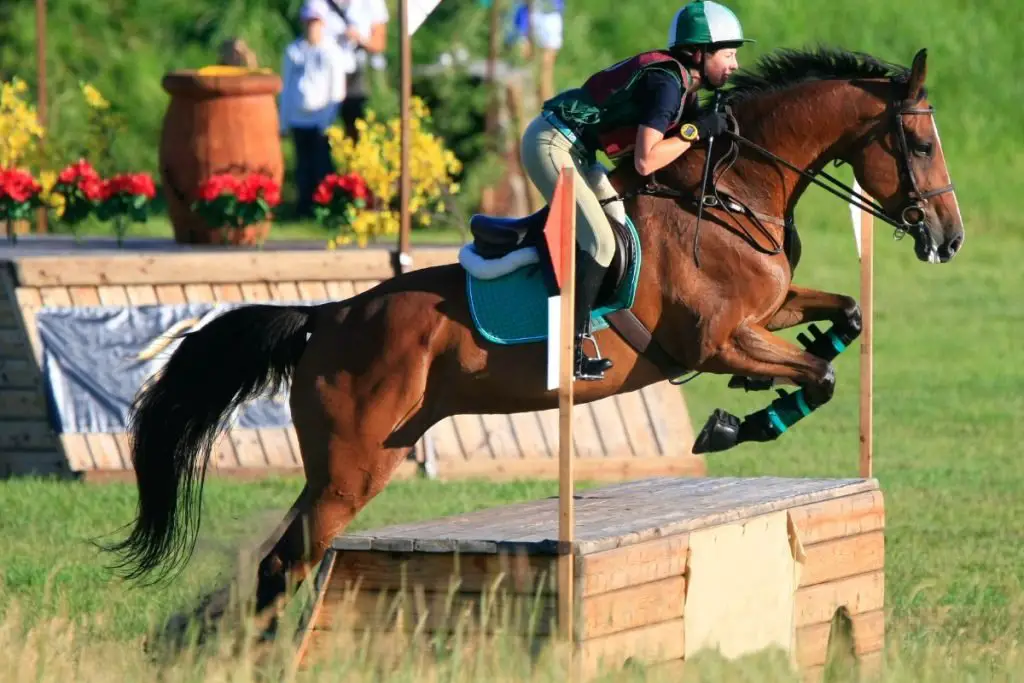
What is horse jumping?
Before explaining the disciplines and classes of horse jumping, in case you’re not clear on what horse jumping is, I am going to give you a brief explanation.
I am also betting the pictures in this article will help a little bit as well.
Horse jumping is usually done on horseback, but free jumping without a rider is also a form of horse jumping.
Free jumping is often used to see how well a horse can jump or as a way to start jump training.
I have done free jumping with my horses sometimes just for fun because they enjoy it. I have also done it with young horses, aged three to four years old, to see their jumping style.
However, for actual jump training, I would wait until the horses are around five.
Horse jumping is when you ask a horse to jump an obstacle with the appropriate signals, and the horse responds by jumping over that obstacle.
Horse jumping can be done just for fun or as a competitive sport.
You can jump a horse over a single fence, a combination of fences, a gymnastic line of fences, or a whole course of fences. There are also different kinds of obstacles they can jump over.
I really enjoy doing gymnastic lines when jump training for myself and the horses.
You can create different combinations of jumps and distances in a jumping gymnastic. It is great for working on straightness, and generally improving the way the horse and rider jump.
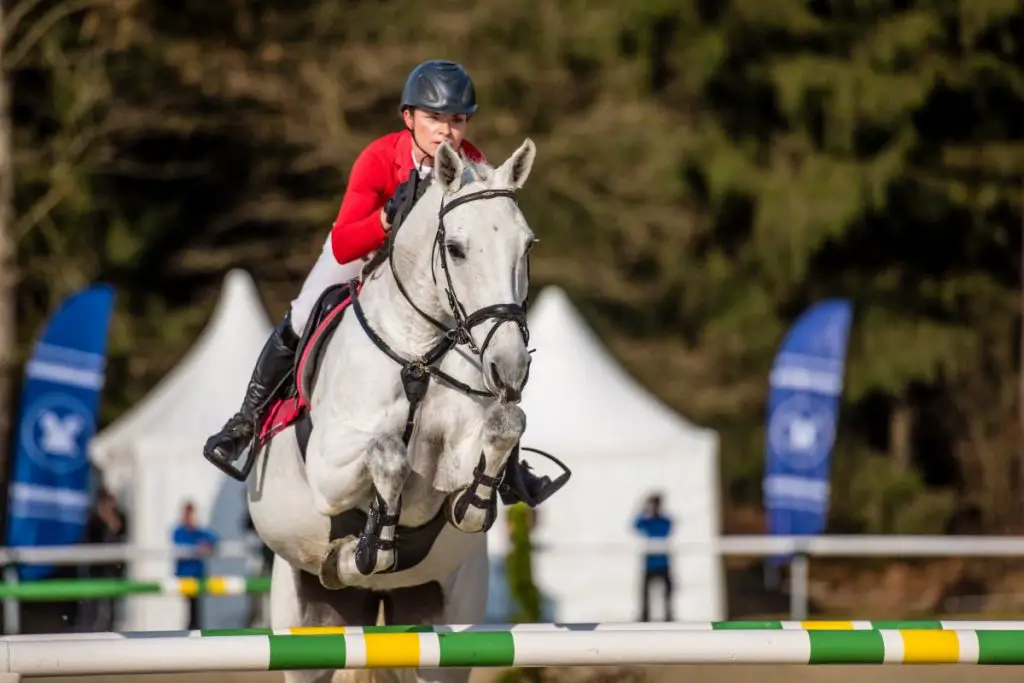
What is horse jumping in the Olympics?
Horse jumping is an Olympic sport, and there are actually two disciplines in the Olympics that include horse jumping.
The Olympics host the disciplines of show jumping and eventing.
The more popular of the two disciplines would be show jumping. However, as a kid, I always dreamed about being in the Olympics for eventing.
Eventing has three phases all together, and two of those phases include horse jumping, show jumping, and cross-country jumping.
The Different Types Of Horse Jumping Disciplines
The disciplines of jumping all consist of horses jumping fences, yet they are all different styles of riding and have different rules, goals, and even types of horses.
Some of these disciplines are based on speed, some on accuracy, some on style and the judge’s opinion, and some on combinations of them.
Let’s take a deeper look at each of the different horse jumping disciplines.
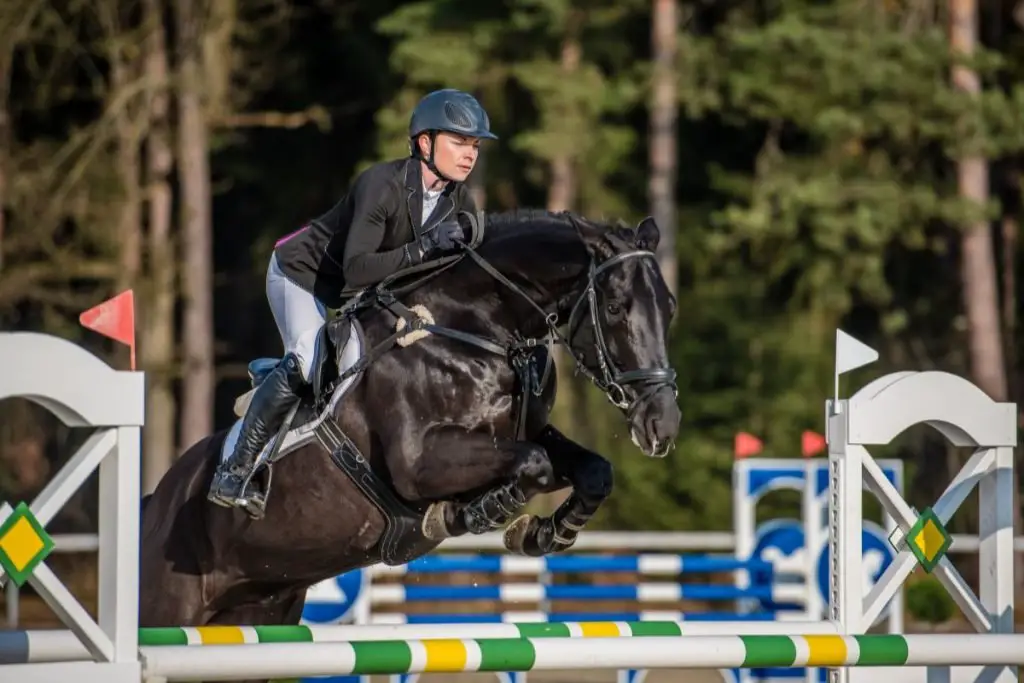
What is show jumping?
Show jumping is a competitive equestrian event in which horse and rider are required to jump a series of specifically designed obstacles with the fastest time and cleanest round (least amount of faults.)
The International Equestrian Federation (Fédération Équestre Internationale, or “FEI”) is in charge of all international show jumping events.
The BSJA (British Show Jumping Association) is the association for show jumping in England.
The USEF (United States Equestrian Federation) is one of the main governing bodies for show jumping competitions in the USA.
- Show jumping can be a stand alone event.
- Show jumping can be part of a hunter jumper competition.
- Show jumping is a phase in the discipline of eventing.
Show jumping is also called stadium jumping or jumpers.
Show jumping competitions are judged objectively based on the speed of the rider and how many faults are incurred.
Show jumping as a separate sport is not the same as show jumping in eventing.
Show jumping as a separate sport is sometimes called “true show jumping,” whereas in eventing it is often called “stadium jumping,” and in Hunter Jumpers it is often called “jumpers.”
- True show jumping (show jumping)
- Stadium jumping (eventing)
- Jumpers (hunter/jumper)
True show jumping has higher jumps than stadium jumping in eventing. I will explain more when I go over eventing.
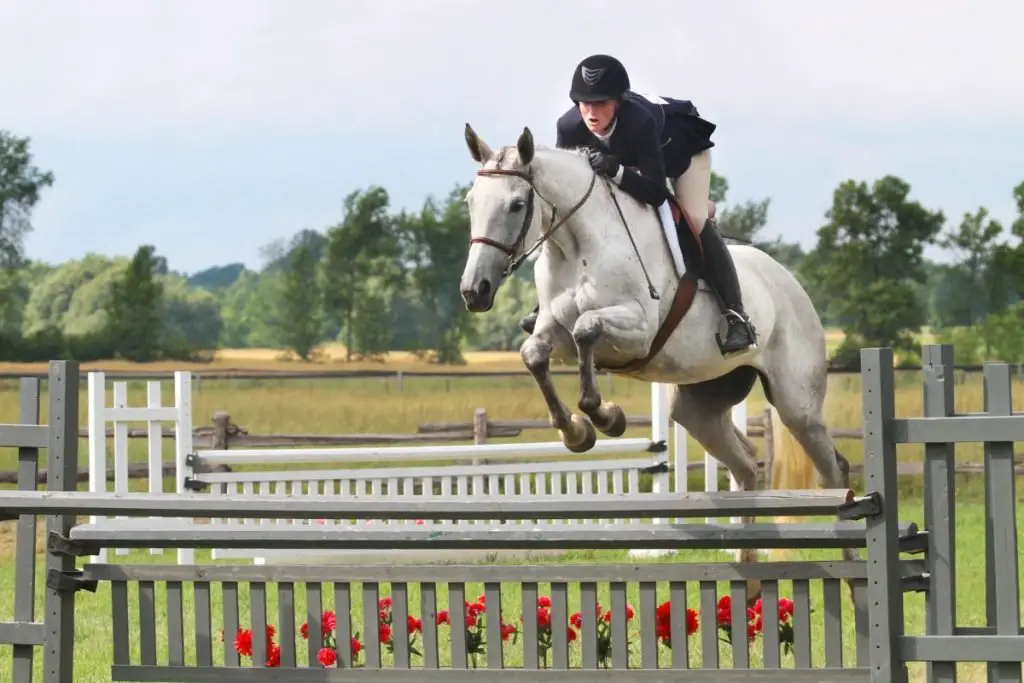
What is hunter jumper?
Hunter Jumper is a combination of two distinct English disciplines. They complement each other like peanut butter and jelly.
In the USA, the main governing body for hunter jumpers is the USHJA (United States Hunter Jumper Association).
There are hunter jumpers in England, but pure show jumping is more common there.
You have hunters, and then you have jumpers. Like I mentioned before, “jumpers” is another term for show jumping, and it is a common term used in “hunter jumpers.”
Hunter competitions are subjectively judged, while jumper competitions are objectively judged.
- Hunters are judged subjectively.
- Jumpers are judged objectively.
I explained before that show jumping is judged based on performance, such as speed and faults. These are like facts.
However, hunters are judged based on the opinions of the judges and how well they think the horse and rider performed, as well as their preferences for the horse and rider’s style.
- Hunters have some flat classes and some jumping classes.
- Jumpers just have jumping classes.
Hunter competitions are further subdivided into hunter and equitation classes.
- Hunter classes
- Equitation classes
They are both subjectively judged, but the hunter class focuses on the horse’s performance and style, whereas the equitation class focuses on the rider’s performance and style.
- Hunter focuses on the horse
- Equitation focuses on the rider
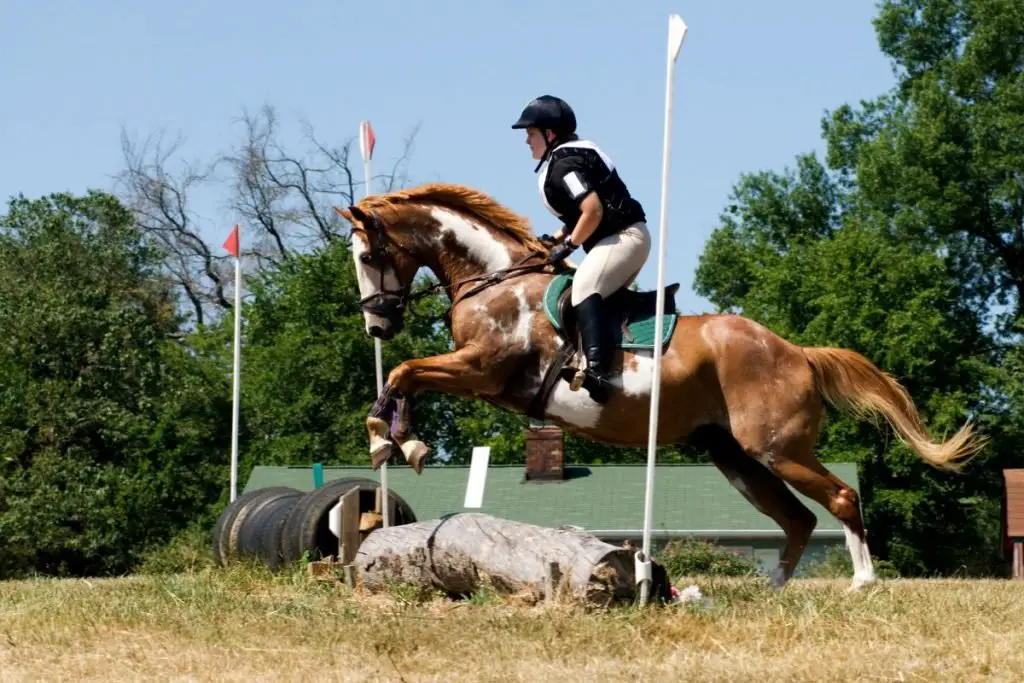
What is eventing?
Eventing consists of three phases: dressage, cross-country, and stadium jumping.
The FEI is the international governing body for eventing.
The governing bodies for the USA are the USEA (United States Eventing Association) and the USEF (United States Equestrian Federation).
The United States Pony Club, once a club for children but now open to adults and children alike, is another association that promotes eventing.
Although it once focused mainly on eventing, the USPC has become a more all-around association with different disciplines.
Eventing can be a two- or three-phase competition that can be completed in one day or over three days. “Three-day eventing” is a common term used because it was originally a 3-day competition.
There are two-phase competitions, like dressage and show jumping, for riders at the lower levels. Three phases in one day are also available at the lower levels. Once you get past the preliminary level, most of the competitions you can enter are only for the three-day events.
Each phase of eventing tests something different in the horse-rider partnership.
- Dressage shows the harmony, grace, and subtle communication of horse and rider.
- Cross-country jumping demonstrates the fitness, bravery, and trust of horse and rider.
- Stadium jumping shows the agility, endurance, and precision of horse and rider.
Stadium jumping usually comes after cross-country jumping.
Often, the horses are tired after cross-country. So they are more likely to have knockdowns or refusals in “stadium jumping.” This tests the horse’s agility and conditioning after the rigorous demands of cross-country.
Cross-country jumping is a timed event where you ride at a fast pace over natural terrain and obstacles.
However, depending on your level, it is more of an optimum time. If you go too fast, you will get penalty points. You need to hit the sweet spot of being at the top of the optimum time while at the same time having no refusals or falls.
Your cross-country score gets averaged into your scores for dressage and stadium jumping.
Stadium jumping is like show jumping, but the jumps are smaller than they would be in a “true show jumping” competition.
This is for the horses’ sake, to take some of the burden from the stress of cross-country. It is already harder for the horses after being tired from cross-country.
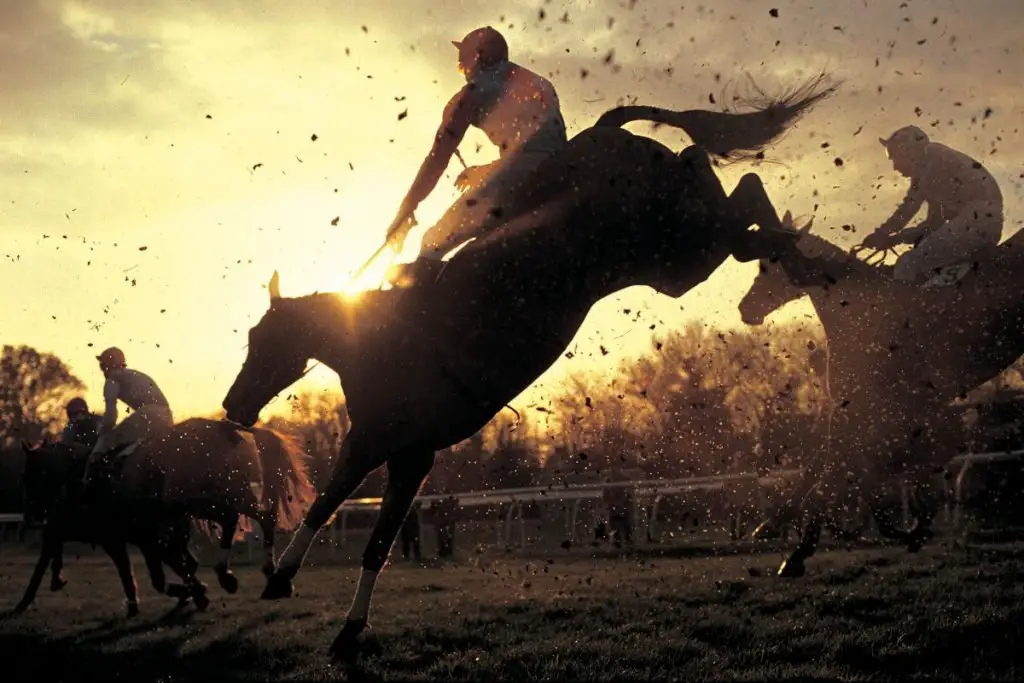
What is steeplechase?
Steeplechase is also referred to as “jump racing,” “chases,” or “hunt racing.”
A steeplechase is a type of thoroughbred racing over fences that combines flat racing and cross-country jumping.
The National Steeplechase Association, Inc. is in charge of jump racing in the United States. Its headquarters are in Fair Hill, Maryland, and it is in charge of licensing horse owners, trainers, and jockeys.
It sets the rules of the sport and organizes entries for races held at racetracks and one-day race meets across the United States.
In England, steeplechase is often called “Hunt Racing.”
The English Grand National, held outside of Liverpool, is the most well-known steeplechase race. This was the inspiration for the old-time classic film “National Velvet.”
The steeplechase sport began in Ireland in 1752 with a horse race from church to church, or steeple to steeple, jumping any obstacles in their path.
Steeplechase is a rigorous sport that is longer than normal flat races. They run over distances ranging from 2 to 4.5 miles (3.2 to 7.2 km).
The racers must jump over a variety of obstacles, which can include simple fences, water jumps, and open ditches. Fences in “chases” are at least 4.5 feet (1.3 meters) tall and made of birch and spruce.
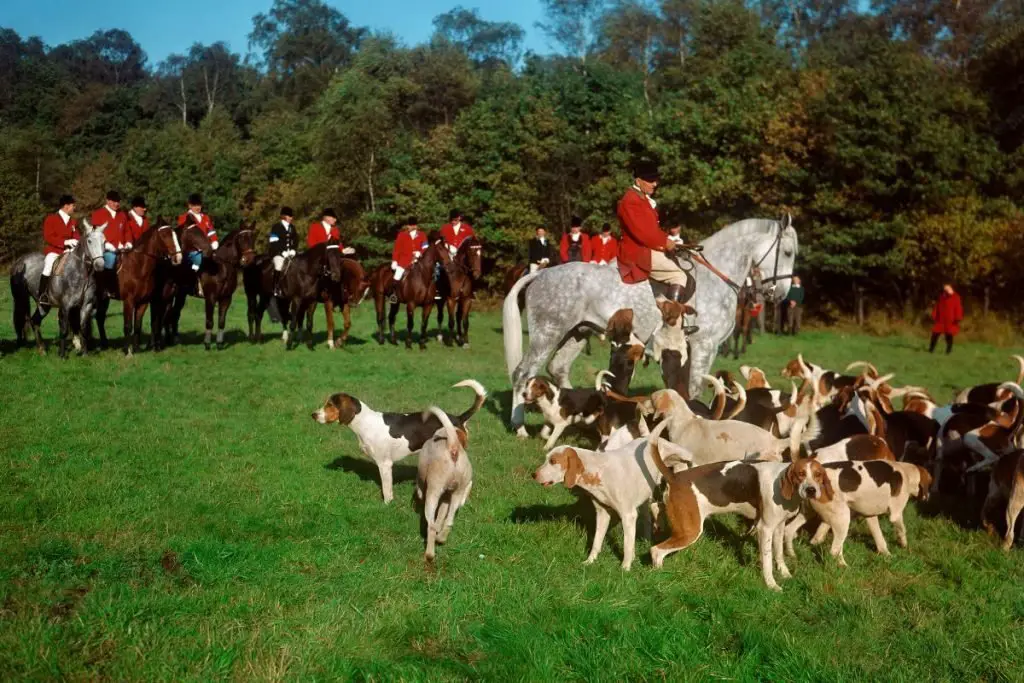
What is fox hunting?
Fox hunting is a riding sport in which trained scent hounds, usually foxhounds, track, chase, and kill a fox, typically a red fox. Riders dress up in traditional attire based on the season and hunt requirements.
Originally from England, fox hunting has been around since the 15th century.
Initially, fox hunting was thought to be a supplement to stag and hare hunting. The hounds were used the same way to hunt foxes as they were for stags and hares.
I do want to note, there are some fox hunts now a days where, instead of hunting foxes, a simulated scent trail is set up for the hounds to follow. Even though it is still possible for some foxes to get caught by the hounds.
The sport is very controversial, especially in the UK. People who support fox hunting say that it is an important part of rural culture and that it helps protect wildlife and get rid of pests. People who don’t support it say that it is cruel and pointless.
There are many places that have banned fox hunting. Northern Ireland, Australia, Canada, France, the Republic of Ireland, and the United States are among the countries that still allow fox hunting.
The reason that fox hunting is on this list is because there is often jumping involved when obstacles are in the way, and the riders must jump the obstacles to stay with the group.
But many times jumping is optional, and there are ways around the obstacles.
My Experience With Fox Hunting
I have been invited and ridden in a fox hunt one time. They used a scent trail with the hounds. So we weren’t actually chasing real foxes.
I was toward the back of the hunt, because there are different positions and ranks in the hunt and I was low ranking. The hounds are at the front and everyone is following the hounds.
Anyway we had all been told to halt and I am not sure why, when a red fox happened to saunter right in front of the horse I was riding.
No one noticed except one man from the hunt club that was in back next to me.
He told me it was very rare to see an actual fox on a hunt and that many riders in the hunt club have never actually seen one on an fox hunt.
We didn’t tell anyone and the fox went out of sight unharmed. It was a pretty cool experience to be able to see one on my one and only fox hunt and I am glad the fox was able to get away safely.
Honestly he didn’t seem too worried. I am also glad the horse I rode that day was so well behaved which I did not expect because he was typically a nervous nellie.
What are the different show jumping classes called?
Show jumping, being the most popular of the jumping disciplines, has several different types of classes or events that may be available at a competition.
- Grand Prix
- Speed derby
- Puissance
- Six bar
- Gamblers choice
- Maiden, novice or limit.
- Match race or double slalom
- Touch class
- Faults converted
| Type of Competition | Description of Show Jumping Competition |
| Grand Prix | Grand Prix the highest level of show jumping competition. Under FEI rules, the horse jumps 10 to 16 obstacles up to 5 ft 3 in (1.6 m) high and 6 ft 7 in (2.0 m) wide. Grand Prix show jumping includes the Olympics, World Equestrian Games, and other events. Five-star CSI rules are used for Grand Prix show jumping. |
| Puissance | Puissance is a high-jump competition with a 7-foot final wall. The current world record is 2.47 m (8 ft 1 in), set in 1949 by Captain Alberto Larraguibel Morales on Huaso. |
| Six bar | Riders jump six fences set in a straight line. Most fences are spaced equally apart, with the first fence being the lowest and each subsequent fence being higher than the one before. If a horse knocks down a rail, they are either penalized or eliminated from the competition. After each round where more than one competitor goes “clean” or has the same number of faults, the six fences get higher for the next round until a winner is found. If there are more than one jump-off, the final fences may be raised to more than six feet. |
| Gambler’s choice | An event where participants choose their own course and each fence cleared is worth a certain number of points based on how hard it is. The winner is the entry that gets the most points in a certain amount of time. |
| Calcutta | Calcutta is a jumping event where people bet on which horse will win by bidding at an auction. The highest bidder gets to bet only on that horse. Even though the exact rules vary from place to place and culture to culture, the person who bets on the winner usually gets all of the money bet and then shares the purse with the owner of the winning horse. |
| Maiden, novice, and limit classes | Maiden, novice, and limit are jumping classes where horses with less than one, three, or six wins are not allowed to compete. Fences are usually lower and time limits more generous. |
| Match race or double slalom | In a match race or double slalom, two identical courses are set up in a split arena, and two horses race against the clock to jump over the courses. |
| Touch class | Touch class is like a regular show jumping class, except if the horse touches the jump, it gets four faults. |
| Faults converted | A class in which any faults are turned into seconds on the clock, usually at the rate of one second per fault (so, one rail = 4 seconds). |
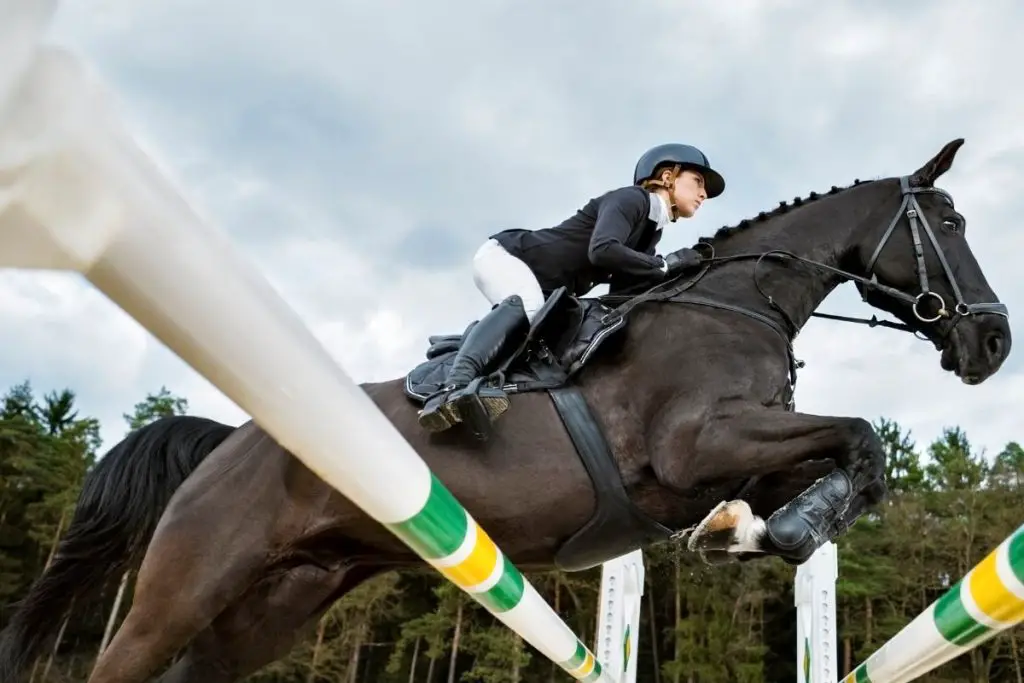
What are jumping horses called?
Jumping horses tend to be labeled by what discipline they compete in or are trained in.
- In eventing the horse would be called an “event horse” or “eventer.”
- In hunter jumpers the horse may be called an “eq horse,” “equitation horse,” “hunter,” or “jumper.”
- In show jumping the horse may be called a “show jumper” or a “jumper.”
- In steeplechase the horse may be called a “steeplechaser” or “chaser.”
- In fox hunting the horse may be called a “mount”, a “fox hunter” or a “field hunter.”
What are horse jumps called?
There are different kinds of horse jumps in each jumping discipline, but in general, horse jumps are called jumps, fences, or obstacles.
Some of these jumps are natural obstacles; some are poles with standards set on jump cups; and some are solid man-made obstacles.
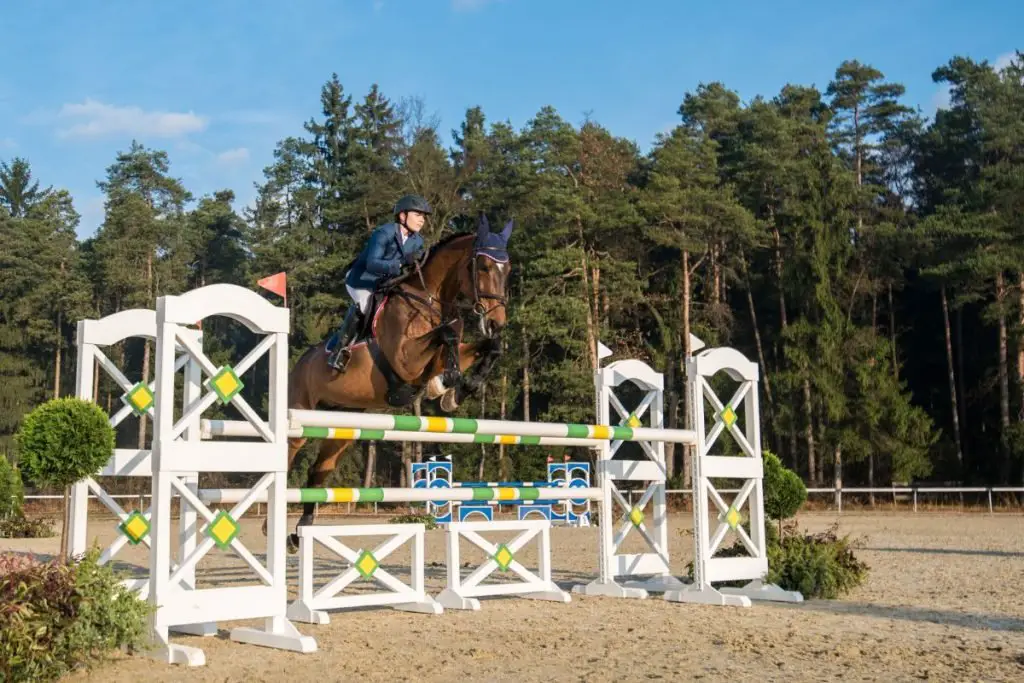
Is jumping horses dangerous?
Yes, jumping horses is dangerous, but to what degree depends on a handful of factors.
There is a risk with riding horses in general, as they are not robots or machines; they are big, strong, and have a mind of their own.
Jumping horses is more dangerous than riding on the flat because there are more chances for things to go wrong.
With jumping, the horse can refuse fences, run out the side of the fence, crash into the fence, or fall over the fence.
The horse has more of a chance of tripping because the balance changes with jumping. Horses can get excited when jumping and may run away or buck at times.
In my experience, I have fallen and gotten hurt most often when:
- the horse is untrained or green.
- the horse has a nervous temperament.
- the horse hasn’t been worked in a while and is feeling energetic.
- when I was not ready for the riding activity I was doing.
That said, there are things you can do to mitigate the risks of jumping horses.
- Make sure you have a riding instructor that can train you well with safety always in mind.
- Ride a horse that is steady and calm in there temperament and trained well for jumping.
- Don’t try to move up the levels too fast make sure you are ready for the next step.
- Learn how to read horses when they are nervous, excited, in pain and confident. And learn what to do and how to react when horses are in each different state. Listen to your horse.
- Be careful trying to force your horse to do something they are really adamantly refusing. They can flip over backwards if they are desperate enough. Take baby steps and go back a step or two to help your horse build confidence if need be.
- Make sure you wear an ASTM/SEI approved helmet and a body protector is something else to consider.
- Always do a tack safety check before you get on to make sure all your tack and equipment are in good shape.
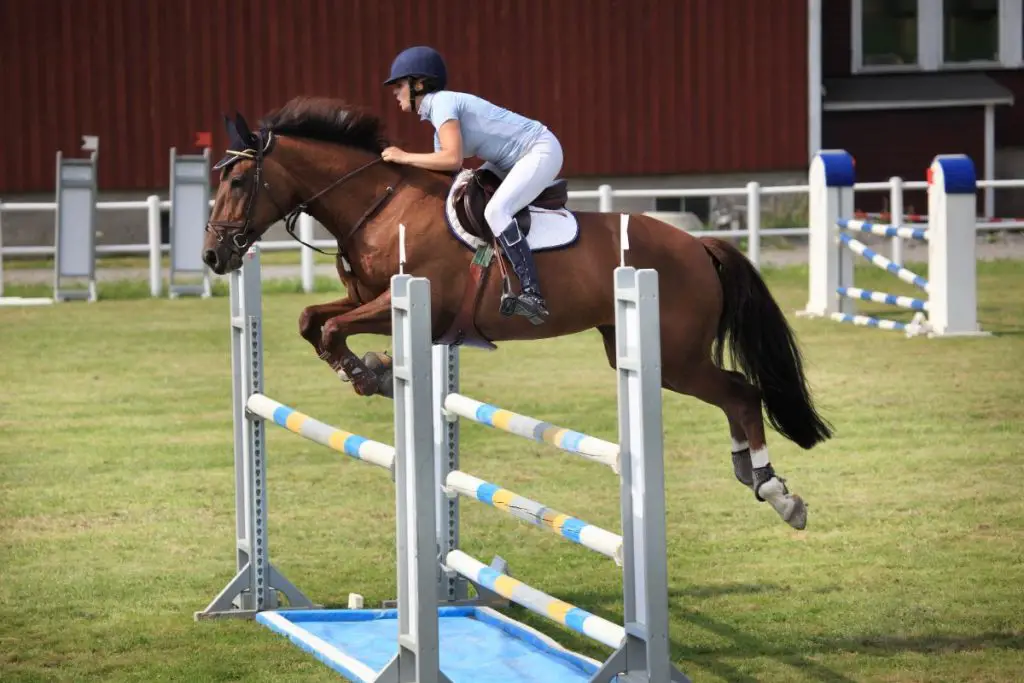
Conclusion
Horse jumping is available in different equestrian sports and is called by different names.
Hunter-jumper, show jumping, and eventing are the most popular English jumping disciplines.
Good luck with naming your new beautiful grey horse!
Cheers, Kacey
P.S. Did you like this article? Gallop over to:

